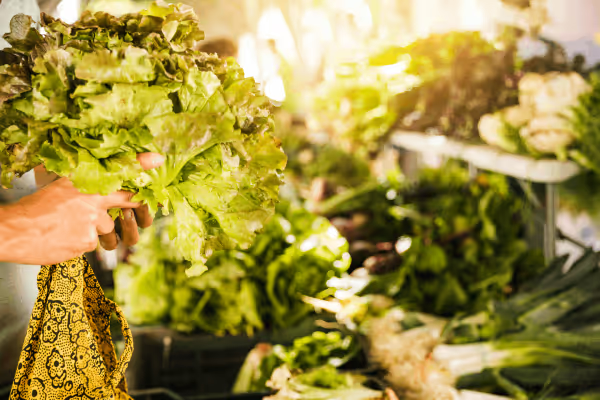
Why Consumers Prefer Locally Grown Farm Produce
Consumer habits are constantly changing, and one of the most prominent trends is the growing demand for locally produced food. Consumers are increasingly choosing products that come not from distant places, but from farms in their immediate surroundings. This shift is not just a passing trend but the result of a growing awareness of the impact food has on health, the economy, and the environment. Supporting local producers has become key to creating more sustainable and resilient food systems, as well as providing consumers with higher-quality, fresher, and more environmentally friendly food.
Freshness and Flavor
One of the main reasons consumers prefer locally grown products is their freshness and superior taste. Locally grown vegetables, fruits, and herbs are harvested when they are fully ripe and quickly reach consumers. This approach not only helps preserve a greater number of nutrients but also results in richer, fuller flavors—something that is hard to achieve with products transported over long distances. On the other hand, commercially produced vegetables are often harvested before they reach full ripeness to withstand the long journey to the market. While these products may be visually appealing, they often fail to offer the same depth of flavor that comes from naturally ripened produce. The flavor difference becomes even more noticeable when comparing local food to that which has traveled long distances, often subjected to processes that reduce its freshness and nutritional value.
Healthier and More Nutritious
Locally grown products are often considered healthier due to their higher nutritional value. Because they are harvested at the peak of ripeness and quickly delivered to market, the nutrients in these products are better preserved. In contrast, commercially produced food that travels long distances often loses a significant portion of its nutritional content. Vitamins and minerals, particularly those sensitive to light and air, such as vitamin C, degrade during transport and storage, making local food a superior nutritional choice. Many local farmers also avoid pesticides, chemicals, and preservatives in their production processes, which contributes to the health of consumers. Smaller farms often practice organic farming or use fewer pesticides, which is particularly appealing to consumers who want to reduce their exposure to chemicals. Buying directly from local farms or markets allows consumers to learn about production methods and be assured that they are choosing products that align with their health, ethical, and environmental principles.
Supporting the Local Economy
Supporting the local economy is another key reason why consumers choose locally produced food. Purchasing from local farms ensures that money stays within the community, directly contributing to the sustainability and growth of the local economy. This way, consumers not only help farmers but also small businesses and families, playing a part in preserving and enhancing the quality of life in their area. Small farmers often face significant challenges due to competition from large industrial farms that have better resources and a broader market. However, by buying local products, consumers help sustain these farms, directly affecting job preservation and promoting agricultural diversity. This practice also fosters the creation of new jobs and strengthens the economic resilience of the community, reducing dependence on external markets and global supply chains. In this way, by supporting local producers, consumers contribute to long-term economic stability and prosperity.
Environmental Sustainability
Consumers are increasingly aware of the environmental impact of their purchasing decisions, and locally grown food is considered a more sustainable and eco-friendly option. The carbon footprint of food largely depends on the distance it travels from the farm to the consumer. Food that is mass-produced and transported over long distances, often from other countries, requires large amounts of fuel for transport, which contributes to greenhouse gas emissions and environmental degradation.
On the other hand, locally produced food has a significantly smaller carbon footprint due to shorter transportation distances. Many local farms practice more sustainable agricultural methods, such as crop rotation, avoiding pesticides, and growing native plant species. These practices help preserve soil health, reduce water usage, and protect local ecosystems. Local farms also tend to use less plastic packaging and rely more on natural resources, further contributing to sustainability. By choosing local food, consumers make a conscious decision to reduce their environmental footprint, support biodiversity, and promote sustainable farming practices.
Building Connections within the Community
Buying local food not only creates strong connections between consumers and those who grow their food but also provides a unique opportunity for direct interaction with producers. Many people enjoy visiting markets, farms, or Community Supported Agriculture (CSA) programs, where they can learn more about production methods, seasonal produce, and the specifics of local food systems. These activities foster trust and transparency, as consumers have the chance to better understand the challenges farmers face and the benefits of supporting sustainable and local agriculture.
In a world where global food supply chains are becoming more dominant, this type of purchasing becomes crucial for rebuilding human connections and preserving shared values. By buying directly from farms or local markets, consumers not only gain a deeper understanding of the food production process but also actively contribute to the preservation of culinary traditions and regional flavors, supporting the sustainability and cultural richness of their community.
Seasonality and Variety
One of the most appealing aspects of locally grown food is the abundance of seasonal products. Local farmers grow a diverse range of fruits, vegetables, and herbs, including varieties that are specific to a region or produced in smaller quantities. Eating seasonally means enjoying food that is at its freshest, healthiest, and most abundant, while simultaneously promoting a varied diet aligned with the rhythms of the seasons. Many consumers are motivated by the idea of eating seasonally, as it encourages them to explore new ingredients, contributing to the preservation of biodiversity and supporting sustainable farming practices.
Transparency and Food Safety
Consumers are increasingly concerned about food safety and the transparency of supply chains. The long and complex paths that products take from farm to market make it difficult for consumers to know where their food comes from, how it was grown, and what was used in its production. Local farms offer greater transparency. Consumers can ask questions about growing practices, pesticide use, and production methods. Many local farms operate with high transparency and are willing to share detailed information about their operations. This builds trust and allows consumers to feel confident in the safety and quality of the food they buy.
The Power of Local Choice for a Sustainable Future
The growing interest in locally grown food reflects a broader shift in consumer attitudes toward sustainability, health, and community. By purchasing local products, people not only support their local economies and reduce their carbon footprint, but they also enjoy fresher, more nutritious food. Connecting with producers, supporting environmentally responsible agriculture, and ensuring food safety have become key factors in shaping consumer purchasing decisions.






